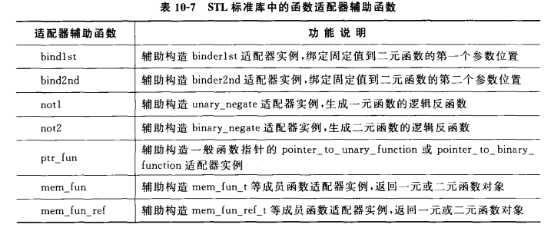C++STL 預定義函數對象和函數適配器
預定義函數對象和函數適配器
預定義函數對象基本概念:標準模板庫STL提前定義了很多預定義函數對象,#include <functional> 必須包含。
1使用預定義函數對象:
void main()
{
plus<int> intAdd;
int x = 10;
int y = 20;
int z = intAdd(x, y); //等價於 x + y
cout << z << endl;
plus<string> stringAdd;
string myc = stringAdd("aaa", "bbb");
cout << myc << endl;
vector<string> v1;
v1.push_back("bbb");
v1.push_back("aaa");
v1.push_back("ccc");
v1.push_back("zzzz");
}
算術函數對象
預定義的函數對象支持加、減、乘、除、求余和取反。調用的操作符是與type相關聯的實例
加法:plus<Types>
plus<string> stringAdd;
sres = stringAdd(sva1,sva2);
減法:minus<Types>
乘法:multiplies<Types>
除法divides<Tpye>
求余:modulus<Tpye>
取反:negate<Type>
negate<int> intNegate;
ires = intNegate(ires);
Ires= UnaryFunc(negate<int>(),Ival1);
關系函數對象
等於equal_to<Tpye>
equal_to<string> stringEqual;
sres = stringEqual(sval1,sval2);
不等於not_equal_to<Type>
大於 greater<Type>
大於等於greater_equal<Type>
小於 less<Type>
小於等於less_equal<Type>
void main()
{
vector<string> v1;
v1.push_back("bbb");
v1.push_back("aaa");
v1.push_back("ccc");
v1.push_back("zzzz");
v1.push_back("ccc");
string s1 = "ccc";
//int num = count_if(v1.begin(),v1.end(), equal_to<string>(),s1);
int num = count_if(v1.begin(),v1.end(),bind2nd(equal_to<string>(), s1));//bind2nd函數適配器
cout << num << endl;
}
邏輯函數對象
邏輯與 logical_and<Type>
logical_and<int> indAnd;
ires = intAnd(ival1,ival2);
dres=BinaryFunc( logical_and<double>(),dval1,dval2);
邏輯或logical_or<Type>
邏輯非logical_not<Type>
logical_not<int> IntNot;
Ires = IntNot(ival1);
Dres=UnaryFunc( logical_not<double>,dval1);
函數適配器




常用函數函數適配器
1綁定器(binder): binder通過把二元函數對象的一個實參綁定到一個特殊的值上,將其轉換成一元函數對象。C++標準庫提供兩種預定義的binder適配器:bind1st和bind2nd,前者把值綁定到二元函數對象的第一個實參上,後者綁定在第二個實參上。
2取反器(negator) : negator是一個將函數對象的值翻轉的函數適配器。標準庫提供兩個預定義的ngeator適配器:not1翻轉一元預定義函數對象的真值,而not2翻轉二元謂詞函數的真值。
常用函數適配器列表如下:
bind1st(op, value)
bind2nd(op, value)
not1(op)
not2(op)
class IsGreat
{
public:
IsGreat(int i)
{
m_num = i;
}
bool operator()(int &num)
{
if (num > m_num)
{
return true;
}
return false;
}
protected:
private:
int m_num;
};
void main()
{
vector<int> v1;
for (int i=0; i<5; i++)
{
v1.push_back(i+1);
}
for (vector<int>::iterator it = v1.begin(); it!=v1.end(); it ++)
{
cout << *it << " " ;
}
int num1 = count(v1.begin(), v1.end(), 3);
cout << "num1:" << num1 << endl;
//通過謂詞求大於2的個數
int num2 = count_if(v1.begin(), v1.end(), IsGreat(2));
cout << "num2:" << num2 << endl;
//通過預定義函數對象求大於2的個數 greater<int>() 有2個參數
// param > 2
int num3 = count_if(v1.begin(), v1.end(), bind2nd(greater<int>(), 2 ) );
cout << "num3:" << num3 << endl;
//取模 能被2整除的數 求奇數
int num4 = count_if(v1.begin(), v1.end(), bind2nd(modulus <int>(), 2 ) );
cout << "奇數num4:" << num4 << endl;
int num5 = count_if(v1.begin(), v1.end(), not1( bind2nd(modulus <int>(), 2 ) ) );
cout << "偶數num5:" << num5 << endl;
return ;
}
C++STL 預定義函數對象和函數適配器
